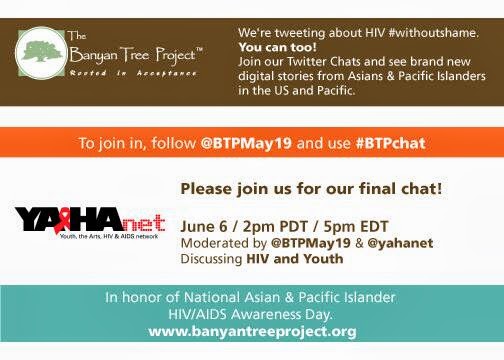To combat the spread of HIV and stigma, we need honest discussions that go beyond politically correct ways of representing today’s realities about the virus without oversimplifying and shaming. That is what these two digital stories offer. Watch and listen.
 Real life storytelling is a powerful way to raise awareness about HIV and stigma. Stories not only convey information but they also communicate values that relate the storyteller and the listener in more nuanced ways. The Banyan Tree Project, run by the folks at The Asian & Pacific Islander Wellness Center, has utilized this human resource and extended it to Twitter chat.
Real life storytelling is a powerful way to raise awareness about HIV and stigma. Stories not only convey information but they also communicate values that relate the storyteller and the listener in more nuanced ways. The Banyan Tree Project, run by the folks at The Asian & Pacific Islander Wellness Center, has utilized this human resource and extended it to Twitter chat.
Viewing Stories on Twitter #BTPChat
They launched a digital storytelling initiative to combat HIV-related stigma in Asian and Pacific Islander communities. For those of you that don’t know, digital storytelling is a workshop-based practice in which participants write their own first-person scripts, record narration, select and scan images, add music, and make 3-4 minute digital videos- in this case, about one’s experience with HIV. The digital stories are uploaded on the project website and have been shared in panels, conferences, and other community discussions to provoke dialogue and community change.
This is how I learned about the Banyan Tree Project (BTP) and watched the two digital stories posted below. BTP organized 5 weekly Twitter chats with guest including TheBody.com and the USA Positive Women’s Network, among others, and framed questions based on digital stories they shared.
You can follow and participate in the chats by following @BTPMay19 and using the hashtag #BTPChat.
June 6, 2012, there will be a #BTPChat about HIV and Youth with the Youth, the Arts, HIV & AIDS Network (@YAHAnet). It starts at 5pm Eastern /2pm Pacific Time and runs for an hour.

HIV and Gay/Bi Men #BTPChat
Last week’s topic was about men who have sex with men and HIV with the National Minority AIDS Council (@NMAC AIDS). Tony’s digital story initiated the chat. Sharing his experience of grief and denial, Tony emphasizes the need for community support which includes the important role of family and friends.
(All videos from the BTP can be watched on their website)
Following the video, @BTPMay19 tweeted these questions for us all to respond.
1) Tony says “Know your status, get tested, seek treatment, find support.” What do gay/bi men need in order to do this?
2) Tony most likely contracted HIV decades ago. How has the gay community’s perception of HIV changed over the last 30 years? #BTPChat
To-the-point answers (you have to be, it’s twitter!) from various HIV outreach professionals and activists rolled out. I’m REALLY generalizing here but comments ranged from issues of disclosure and stigma, the need for everyone (not just poz folks) to have updated info on the manageability of HIV; and the urgency of different ways to frame HIV facts that resonate with different communities.
In the second video “Side Effects”, a sexual health educator candidly explains what led to his choice to have sex without a condom. He reveals that he’s secretly on post-exposure prophylaxis (PEP) and works through his guilt.
The #BTPChat question posed were:
1) PEP/PReP can protect against HIV exposure. What do you think this means for gay/bi men relationships?
2) What challenges do gay/bi men still face when getting tested/treated for HIV? #BTPChat
Also, one of the guest moderators, @NMAC AIDS, asked if this storyteller is a hypocrite and if outreach professionals would use this video when teaching prevention? Again, I’m writing a very simplified overview but I think it’s fair to say that most twitter participants felt this story was the kind of frank discourse needed to tackle taboo subjects like drugs and unsafe sex. Every participant seemed to express support for PEP/PReP stating that it offers more options for different relationships and circumstances. Comments did touch upon the inaccessibility of PEP/PReP due to high costs. It was also emphasized that such treatment must be coupled with promoting regular testing and condoms use in appropriate circumstances. Other participants mentioned that condom stigma needs to be taken more seriously by activists.
Post-Thoughts?
The creation and (careful) distribution of these digital stories have potential to make people rethink assumptions about HIV issues and stereotypes of people living with the virus. These are not HIV experiences typically represented in national public discourse. You will not find them in H&M or state-funded sex ed classes. In some ways, they uphold harmful stereotypes that reduce people with STDs and infections as deviant and careless. The storytellers admit to dissent, recklessness, negligence and guilt. But that is the power of these stories- honest talk that keeps it real.
They expose the trickiness of discussing HIV-related topics without subconsciously casting moral judgment. People are slutty, people are negligent and irrational, people use drugs and take part in abusive relationships (be it with themselves or another).
However, these digital stories are not innately effective at combating HIV stigma and posing discussion. They require careful framing. Dialogue needs to be monitored and kept tailored for particular audiences in order to respect the storyteller and effectively combat myths and stigma that might be decoded by the audience. I think the people at APIWellness who run #BTPChat do a great job at this and I hope they continue to twitter #withoutshame.
What are your responses to these digital stories and the #BTPChat questions?
